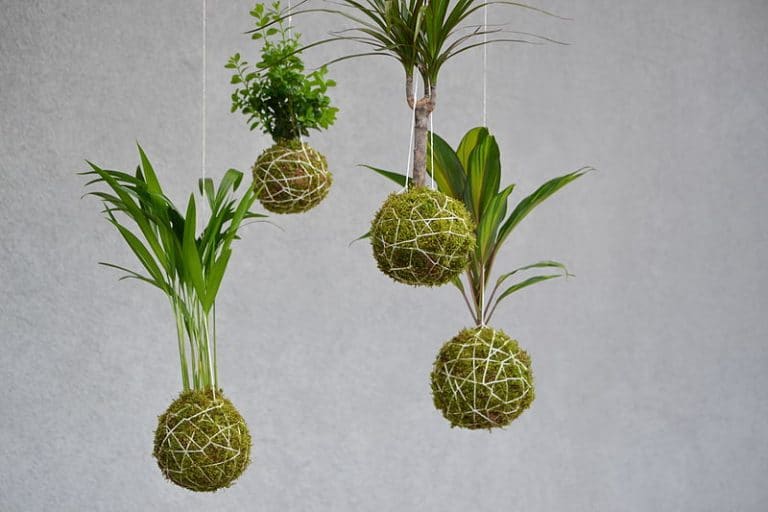
From the Hanging Gardens of Babylon in 600 BC to Boston ferns suspended in baskets more recently, plants have been given an elevated status by gardeners for years. Moss balls, taking inspiration from the Japanese aesthetic of minimalism, offer a different, distinctive take on hanging plants.
Also called Japanese string art, or kokedama, the project comprises a plant encased in a rounded handful of soil, then wrapped in moss and bound with string. The sphere may be placed in a shallow bowl or on a pedestal or, more typically, hung from a perch.
Can this creation be called art? A movable feast, if attached to a pulley?
Whatever else you may call them, moss balls are quick and easy to make, as well as easy on your budget.
“They’re therapeutic, too,” says Jennifer Daniels, owner of Daniels Flower Shop in Windsor, N.S., who guided me through the process in about 20 minutes. “There’s value in that.”
You can create a constellation of hanging spheres, should you choose to, indoors or out. If you’re using your moss ball as a non-airborne focal point, consider clustering other items with it on its perch, such as a small statue, a starfish or stone.
Use one plant per sphere—what we outline here—or experiment using a few in one. Choose from plant forms such as cascading, upright and arching to create symmetrical or asymmetrical designs. The sky’s the limit.
Materials
- Plastic or newspaper to cover working surface
- Small bucket or tray
- Gloves (optional)
- Soil
Traditionally, kokedama is made with bonsai soil, which is granular and clay-based, in order for it to hold together but also drain well. However, since it isn’t always readily available, we improvised by mixing half orchid potting soil and half regular potting medium.
- Strong string or twine
Use nine feet (2.7 m) as a guide, so you have enough to hang your sphere as well as wrap it.
- Scissors
- Sphagnum, sheet or Spanish moss
We used a combination that included reindeer moss as well, for contrasts in texture and colour.
- Plants
Start small. Consider using houseplants growing in four-inch (10-cm) pots that like bright, indirect light, says Jennifer. Depending on the plant, creations for indoors can spend summer months outdoors in a partially shaded location; Mother Nature can lend a hand with watering. You can also make Japanese moss balls with annuals or perennials expressly to adorn your outdoor living space. Here are some candidates on both counts.
Bulbs (muscari, small tulips)
Coleus
Dusty miller
Ferns (frosty, asparagus)
Geranium
Herbs (rosemary, lavender)
Ivies
Orchids (Phalaenopsis)
Pansies, violas
Strawberries
Succulents (echeveria, jade)
Variegated vinca
Method
- Lay plastic or newspaper over your work surface. Mix the soils together, and soak with water in the bucket. Mound a couple of handfuls together to form a ball, squeezing out excess water. Note that the ball needs to accommodate your plant’s roots—Jennifer suggests using the size of an orange as a guide.
- Place your twine on the work surface. Lay a damp blanket of moss across the string, estimating how much you’ll need to cover the surface of the soil. Place your sphere of soil on the moss, and make a hole at the top.
- Remove the plant from its pot; loosen the roots and gently brush away the soil. Place the roots in the hole you created, shoring up soil around the root ball to where it was in the pot, shaping and squeezing gently to recreate a sphere.
- Cover the ball with the moss, and begin wrapping the string around to secure it in place. Start wrapping at the bottom, tucking in the moss as you go, being careful not to crush leaves or stems. Radiate out until you are going side to side, back and forth, criss-crossing, pushing in the moss to create a ball as you go. Tie off the ends.
- If you’re going to hang your moss ball, attach pieces of string on two sides of the sphere and tie ends together at the top, creating a hanger.
- Once a week, soak the moss ball for about 10 minutes in a pan of water. If you’re suspending it, let it drip dry before hanging back in place. Follow package directions for fertilizer, reducing to quarter strength.

Eastern influence
Gardeners are always looking for something new or novel—in this case, taking inspiration from the Japanese aesthetic of minimalism. Zen gardens, bonsai and ikebana are all examples of the less-is-more philosophy, whereby beauty is determined in part by understated simplicity; naturalness, or absence of pretence; asymmetry, symbolizing imperfection; surprise, indicating freedom from habit; and suggestion rather than revelation, allowing for nuanced interpretations and symbolism.


Woudn’t plants like ferns and succulents need different types of soil? Any recommendations for succulents?